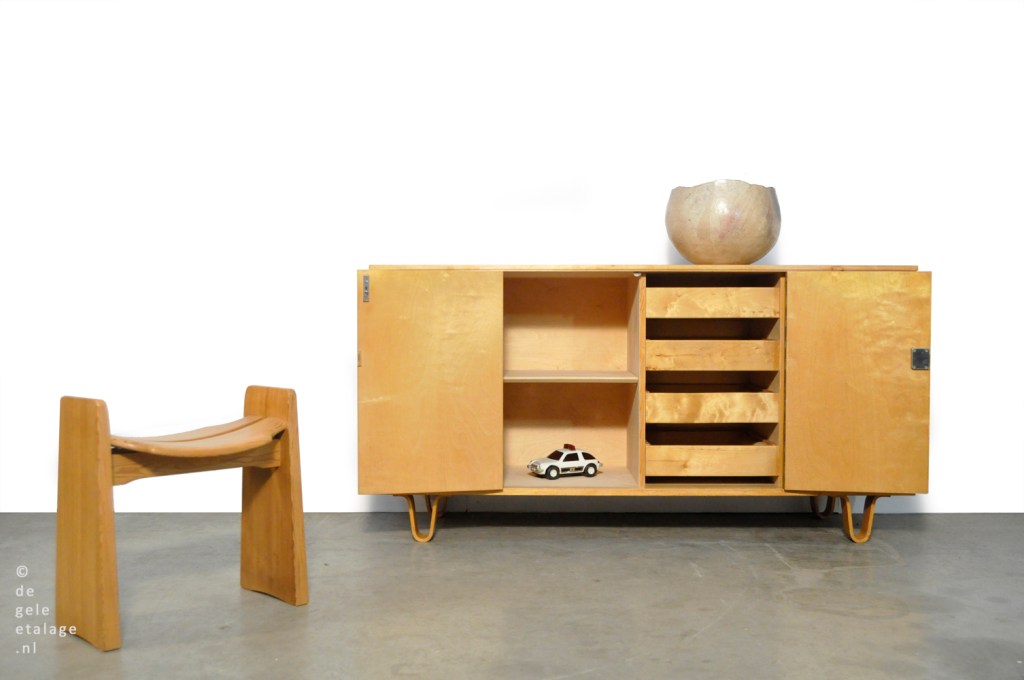SOLD (Groenekan / NL)/

Stylish Birch series sideboard DB02 by Cees braakman for Pastoe, 1950s / stijlvol dressoir, DB02 ontworpen door Cees Braakman voor Pastoe, 1950 Nederland. Het minimalistische dressoir uit de Berkeserie heeft een berken vineer afwerking, staat op de karakteristieke plywood luspoten en heeft de bekende anti-dust lades. Achter de twee harmonicadeuren bevinden zich vier lades en planken. Het vintage meubel is van de eerste eigenaar en gemerkt met Pastoe stempel.
Conditie: zeer goede vintage conditie. De bovenzijde heeft enkele krasjes (zie detailfoto’s). Aan de binnenzijde zit een kleine beschadiging aan de rand van het kastdeurtje (zie foto). Het dressoir wordt in originele staat aangeboden.
Afmetingen: breed 154 cm, diep 47,5 cm, hoog 79 cm
Code: K2201
stylish sideboard, DB02 designed by Cees Braakman for Pastoe, 1950 Netherlands.
The minimalist sideboard from the Bircheserie has a birch veneer finish, stands on the characteristic plywood loop legs and has the well-known anti-dust drawers. Behind the two concertina doors are four drawers and shelves. The vintage furniture is from the first owner and marked with Pastoe stamp. Very good vintage condition. The top has some scratches (see detailed photos). There is a small damage to the edge of the cabinet door on the inside (see photo). The sideboard is offered in its original condition.






ORDER / CONTACT
Contactform
After receiving the form we will contact you as soon as possible. Thank you in advance, Derko-Jan
🟡 Dutch ART DECO beech chair by the firm Jac Levee NV, 1930s
Beautiful Art Deco armchair designed and manufactured by the Amsterdam firm Jac Levee NV around 1935. This beechwood armchair in the Amsterdam School style is a beautiful combination of traditional craftsmanship and modernist design principles. The black-painted round accents give the chair a distinctive character. The wicker seat provides comfortable seating. Original Art Deco / Amsterdam School design.
#artdeco #amsterdamschoolstyle #craftsmanship

🟡 JAPANESE ANTIQUES
A beautiful Japanese wooden mobile Tansu (箪笥) cabinet from the Meiji period, circa 1900, with a beautiful patina. The cabinet was primarily used for storing clothing, especially kimonos. This functional approach is clearly reflected in the metal corner protectors and the lockable drawers and sliding doors. This cabinet has several wide drawers, two sliding doors, and two “hidden” drawers behind a door. A nice detail is the cast iron supports on the sides of the cabinet. More interesting information about this characteristic piece of furniture with a rich history can be found on Wikipedia/Tansu, among other places. Beautiful cabinet in a modern interior or brutalist architecture.
On Hold
#tansu #japaneseantique #furniturehistory

🟡 REUSE FRIDAY
Buy timeless vintage design and make this Black Friday a little greener and more sustainable.
Buy what you need.
For beautiful, authentic, original furniture made with craftsmanship, you’ve come to the right place.
You can find our timeless beauties at www.degeleetalage.nl or @de_gele_etalage
#greenfriday #buyvintage #secondhand

🟡 PIRKKA
Iconic Scandinavian dining chairs, model Pirkka, designed by Finnish interior architect Ilmari Tapiovaara and manufactured by Laukaan Puu in the 1950s. The chairs (5 pieces) are made of high-quality pinewood and feature a beautiful brown finish and black lacquered legs. Beautiful craftsmanship with elegantly shaped components and solid mortise and tenon joints. Early edition and original marked mid-century set. A beautiful set together with the restored dining table.
#pirkka #scandinaviandesign #finnishdesign finnishvintage finnishmidcentury midcenturydesign interiordesign iconicvintage iconicdesign scandinavianvintage scandinavianmidcentury ilmaritapiovaara laukaanpuu chairs1950s craftmanship earlyedition interiorstyle scandinavianstyle bohostyle bohemianstyle stylishvintage timelessvintage degeleetalage vintyagedealer vintagenetherlands

🟡 Autumn light
All items available at www.degeleetalage.nl or sent a message.
Beautiful Rosewood sideboard by Leo Bub, Germany 1960s
Natural wooden side tables
Mid-century round rope mirror Adrien Audoux & Frida Minet, France 1960s
Buffalo leather armchair by Leolux, Netherlands 1970s
Small wooden bookshelf
Handmade (homemade) wooden bookcase 1970s
Wooden coffee table with inlaid ceramic tiles by Ebbe Sorensen, Denmark 1970s
Globe 2000 floorlamp by Frank Ligtelijn & Raak Amsterdam, Netherlands 1960s (sold)
Antique and primitive farm bench, 1900
Natural wooden brutalist vintage furniture with a warm character.
#leobub #rosewoodsideboard #raresideboard #treestumptable #adrienaudoux #fridaminet #ropemirror #midecenturyfurniture #brutalistfurniture #interiordesign #warminterior #brutalistinterior #buffaloleatherarmchair #leolux #70sarmchair #brutalistarmchair #woodenbookshelf #ceramictilestable #ebbesorensen #danishdesign #globe2000 #frankligtelijn #raak #vintagefloorlamp #vintagedealer #vintagedeventer #vintageamsterdam #worldwideshipping #newantiques






